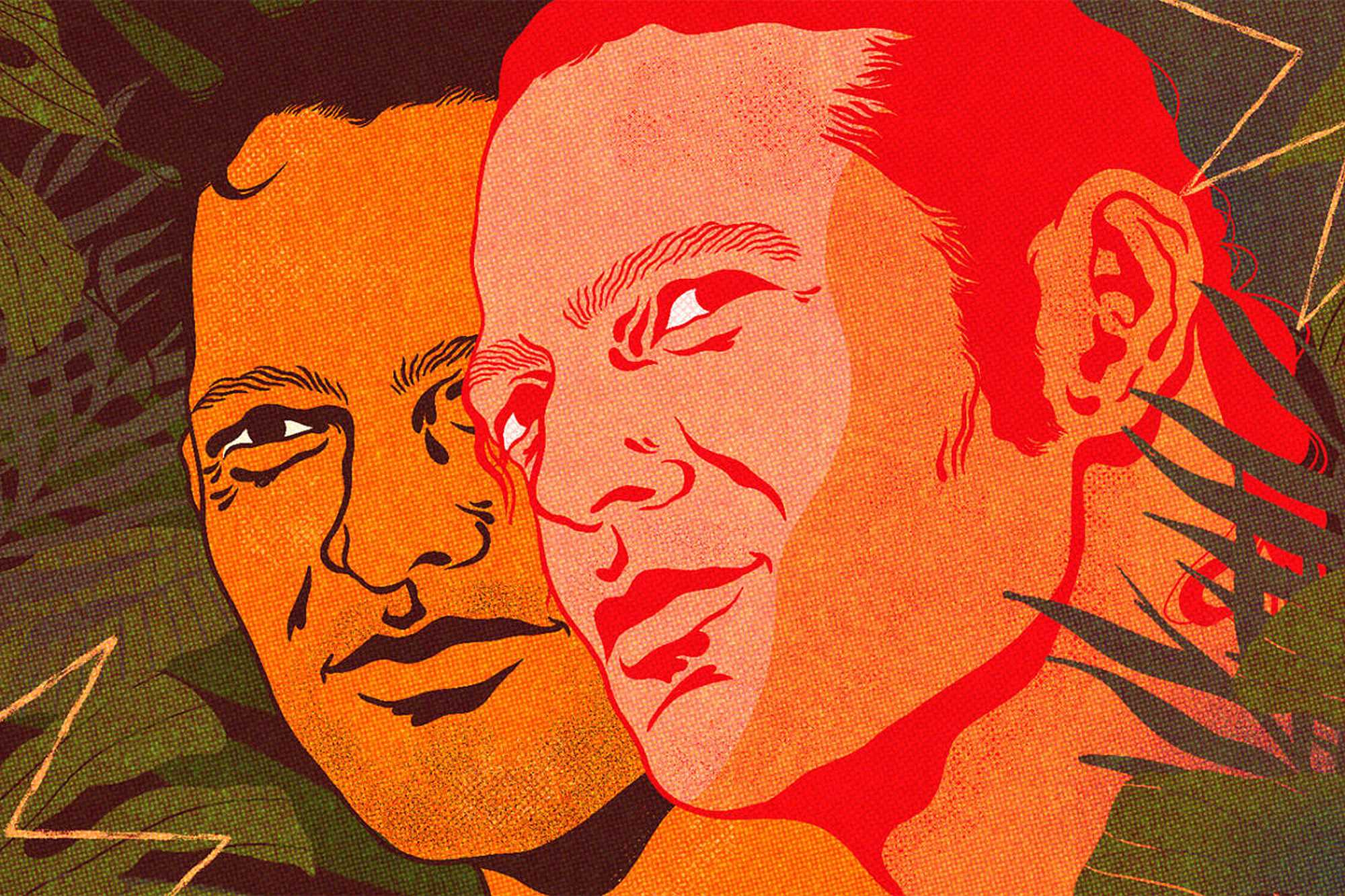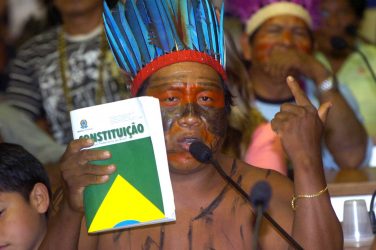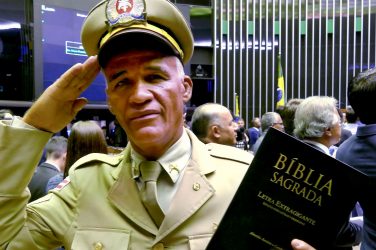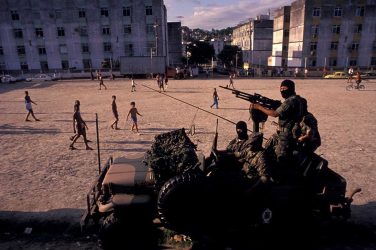Fernando dos Santos Araújo woke up alongside his love, Bruno Pereira Gomes, on May 24, 2017. They were camping together in the Pau D’Arco jungle, a municipality in the Amazonian state of Pará in Brazil. That morning, Pereira Gomes teased that he had spent the night shivering. “Tonight, you give me your blanket,” he joked as Araújo handed him his coffee.
Not long after, the gray sky erupted into a downpour. A storm had arrived – and with it, clouds that would follow Araújo for the rest of his life. Later that morning, Pereira Gomes was shot dead. And Araújo bore witness. Perhaps the Earth knew of the violence to come that morning, releasing its sorrow through sky-shattering streams. The Earth’s tears may have helped cleanse the land of the cursed bloodshed, but no amount of water would ever wash away those sins.
That tender morning is one of Araújo’s last memories with his beloved, which he shared with journalist Ana Aranha for a documentary she’s filming with Repórter Brasil. The couple had been part of a land occupation on the Santa Lucia farm in Pau D’Arco that began about three years prior. Farmers like themselves don’t exploit the land, which is under constant threat of fires and land-grabbing. They’re small-scale, growing crops like pumpkins and beans.
They hope to build sustainable communities with schools and clinics. This vision didn’t stop the police from arriving with arrest warrants that morning. The rural workers evaded their orders and, instead, hid in the rain-soaked jungle. The officers responded with bullets. Ten people were killed in the Pau D’Arco massacre.
On January 26, 2021, nearly four years later, Araújo suffered a similar fate. He was killed in his home.
Today, the surviving families – which includes at least one orphaned teenager – are still waiting to see justice. All the while, they’re encased in fear, especially after Araújo’s suspicious death this year. He was the main witness for the lawsuit related to the massacre. Advocates and allies believe his attack was a warning: Speak out, and you’ll be next.
It’s a threat land defenders across the world know intimately. In 2020, at least 228 environmental land defenders were killed in 25 different countries. The true number is likely higher. And the situation in Pará is growing severe: Though it’s home to only 4% of Brazil’s population, more than 30% of the deaths occurred there from 2015 to 2019, according to data human rights organization Global Witness provided.
The Brazilian parliament – led by President Jair Bolsonaro, who openly opposes landless workers – is considering two bills this year that would further erode their rights and embolden land grabbers who would prefer to leave nothing behind for rural workers like Araújo.
“We cannot normalize the killings of people who are protecting the land,” said Ivi Oliveira, protection coordinator for the Americas with Front Line Defenders, an Ireland-based human rights group. “In a country like Brazil, they are pretty much the only ones protecting it.”
To Brazil’s right-wing leaders, these small-scale farmers are terrorists. To the climate movement, they’re survivors – Earth warriors.
That intimate May morning in the jungle quickly went south for Araújo and his partner, Pereira Gomes. They huddled under a plastic tarp to stay dry from the rain when they saw the 17 officers approaching. The couple and their fellow comrades tried to hide, but it didn’t take long for the police to find them. The officers were clear: Run, and we’ll shoot you. Turns out, the officers planned to fire regardless.
When Araújo and Pereira Gomes stood up to run, the officers sent a flurry of bullets their way. Araújo only survived because he played dead. Pereira Gomes was killed, and Araújo fell over his body where he stayed lying in a pool of his boyfriend’s blood. Once Araújo felt the police weren’t looking, he crawled to a nearby bush where he hid and heard his friends’ final moments. Those who obeyed the officers’ orders didn’t get to walk away. Araújo heard their groans and cries as the officers berated and tortured them before ultimately shooting them. Araújo managed to slip away.
This massacre has fueled the Landless Workers Movement in Brazil – a movement predicated on a simple fact: Land is power.
This truth dates back to the 16th century when the Portuguese arrived. The country’s first democratic constitution – written in 1988 after decades of dictatorship and centuries of colonialism – attempted to implement land reform through this lens.
And yet, the country has seen little success: 1% of the population controls nearly half of all the land while 4.5 million families own no land. These are the numbers behind ongoing human rights concerns in Brazil – and a reality Araújo hoped to change.
“A lot of this is part of our colonial heritage,” said Sérgio Sauer, a professor of environment and rural development at the University of Brasília. “Land is the main struggle, but there’s a combination of different demands from the movement – from housing, education, and public transportation.”
Not all landless workers organize through the Landless Workers Movement, or Movimento dos Trabalhadores Rurais Sem Terra (MST) in Portuguese, but the movement benefits all rural workers in search of land and demanding agrarian reform, Sauer said.
“Landless workers” can refer to a number of situations: workers farming with little to no pay who long for their own land, farmers who own a bit of land but not enough to sustain their families, and individuals who camp along roads, demanding land and work. The pandemic has made the latter less common as these encampments require energy and organizing, which the pandemic has depleted for many.
Currently, each piece of rural property – often used for agricultural purposes – must serve a social function. The constitution requires it. Article 186 lays out what’s expected of rural properties, which includes “rational and adequate use.” If landless workers find an unproductive piece of land, they technically have a right to claim it. To put pressure on the government, workers have been occupying and farming such lands since the 1980s.
Not every struggle wins, but this is one of the only avenues for landless workers to secure land. Once the government can document that the land isn’t serving its societal function, it can buy the land and include it in its program to provide land to rural farmers without any. About 370,000 families have been successfully settled this way, according to the MST.
These landless workers don’t aim to produce a whole lot, either. They serve a similar ecological function as Indigenous and tribal peoples do in the region – farming the land sustainably without cutting down much forest. They’re a better alternative to the industrial soy plantations, cattle ranches, and gold mining behind the deforestation in the Amazon, yet they face an uphill battle to see their constitutional right to land realized.
“Brazil is an interesting country because, in theory, everything is very beautiful,” said Marina Comandulli, a campaigner with Global Witness’s land and environmental defenders team. “We have this beautiful constitution that talks about fundamental rights, the right to land. The problem in Brazil is that despite the fact that, in theory, we have everything and everything is beautiful, it’s difficult when it gets to the implementation stage.”
Take the Santa Lucia farm, for example. In 2013, a formal land occupation began because the farm appeared abandoned. It had also been marked as a potential settlement for farmers in 2002. Despite these favorable signs, the situation grew complicated for Araújo and his peers. The records named businessman Honorato Babinski as the owner, so his family pursued a legal battle over the land despite it not serving that “social function” the constitution requires.
On April 30, 2017, the situation intensified after a security guard working for the Babinski family was killed on the property. The police who carried out the massacre less than a month later came to the farm to arrest those allegedly involved. The accused never got to see their day in court.
Weeks after the massacre, some occupants returned, including Araújo. They even renamed the land in honor of the camp’s late leader: Acampamento Jane Júlia. Manoel Gomes, the president of the farm association representing the Santa Lucia workers, remembers his hesitancy to return after the massacre. A friend of his had lost seven family members, and he didn’t want their lives to have been taken for nothing. So Gomes got to work, setting aside a piece of land for each family who returned with him.
“We still live here because we hope that the occupation will be legalized one day, but we’re also afraid,” Gomes said in a written response. “We have a hope, we have a dream, and we have faith that this will be solved, that there may be a settlement and that we won’t have to face an eviction.”
By 2018, the situation finally looked promising for the workers. The Babinski family had accepted a 21.9 million reais offer from the National Institute of Colonization and Agrarian Reform, or INCRA in Portugese, the Brazilian agency that buys such lands in landless worker settlements.
Once Bolsonaro came into office in 2019, however, that payment process ended due to his defunding of environmental and land reform initiatives. Now, the family is pursuing legal ownership and eviction again. The only reason the families haven’t been evicted is because of the ongoing pandemic, which has killed more than 12,000 people over the last week in Brazil, the country with the third-largest number of cases.
“Santa Lucia farm is the portrait of the feudal model of the Brazilian State,” said Jose Vargas Junior, the attorney representing the workers, in a statement. “When there was slavery, the commodity was the slave; with the abolition of slavery, the commodity became the land.”
Gomes sees this inequity clear as day; this one family would benefit from land that could, instead, provide shelter to the 200 families who currently live there. And these workers provide a valuable service to the country, selling their surplus produce. In fact, family farms (like the ones on Santa Lucia) supply 70% of the food eaten in Brazil despite making up less than 25% of the country’s agricultural land. Still, these farmers have little governmental assistance to support them.
“We need recognition from society that our job is valued for humanity because, without food, nobody survives,” Gomes said.
Pará carries a history of survival – and of death. It sees the highest death rate for environmental defenders among the 12 states for which Global Witness provided data. (Global Witness conducts a rigorous process to verify every death. The group has certain criteria, such as the death should be related to environmental or land issues and the person should be standing up and protesting an environmental issue or protecting the land.)
Pará is known as one of the most dangerous regions in the country. It’s vulnerable to illegal land-grabbing due to the amount of public forestlands available. This puts rural and landless workers at risk, but the region’s violent history dates back decades before the Pau D’Arco massacre.
In 1996, 1,500 landless workers were marching to the city of Belém, Pará. They were protesting delays in receiving land. Along the way, they camped by a highway in Eldorado de Carajás, a municipality in southeastern Pará not far from Pau D’Arco. Officers arrived with orders to clear the road – to which the workers responded with literal sticks and stones. The officers escalated the situation with gunshots. Nineteen people died that day, and more than 60 were injured.
Though more than 150 officers were allegedly involved in the Eldorado dos Carajás massacre, only two commanders have been incarcerated. If it were up to President Bolsonaro, they’d be free. In 2018, while campaigning for office, Bolsonaro defended those officers serving time for the massacre.
“Who should’ve been imprisoned were the people of the landless movement, scoundrels and vagrants,” Bolsonaro said during a speech in Eldorado de Carajás. “The police responded to not die.”
To that, Vargas responded: “The message is more than impunity. It is heroism for certain criminal behaviors.”
As a gay man, Araújo struggled growing up in Redenção, south of Pau D’Arco. “He really paid the price for being gay in a rural area,” said Aranha, who spent four years interviewing Araújo before he was killed. As a teen, Araújo moved to the capital city of Brasília with his friend who was a hairdresser where he was able to explore his sexuality. Still, he couldn’t shake the call of the countryside. He heard about the Santa Lucia farm while visiting his mom in Redenção. “Dreaming of having a piece of land to live and cultivate, he joined the occupation,” Vargas said.
Araújo fell in love on the land. His first romance involved a young man whose father kicked him off the farm after not accepting their relationship. Araújo always spoke of him. Then, he met Pereira Gomes, whom he lost in the massacre. After that, he grew lonely. He longed for a partner, “someone to be alone with me, to share the loneliness of the world,” Vargas recalled him saying.
Araújo’s combined identities as a landless worker and a gay man may have made him an even bigger target to the evil forces at play, said Gustavo Coutinho, a lawyer who sits on the board of directors for the Brazilian Gay, Lesbian, Bisexual, and Transgender Association. After all, the president has also been vocal about his hate toward the LGBTQIA+ community.
As far back as 2002, President Bolsonaro said, “I’m not going to combat or discriminate, but if I see two men kissing on the street, I’m going to hit them.” In 2011, he said: “I would be unable to love a gay son…I would prefer that my son die in an accident.”
Coutinho began his human rights work with the LGBTQIA+ community, but he also works with environmental organizations, as well as Indigenous and rural communities. He’s currently collecting data to ensure every LGBTQIA+ murder is registered so that organizers can demand accountability.
In 2019, 329 LGBTQIA+ people were violently killed in Brazil, according to the Gay Group of Bahia, a human rights group centered on the queer community. Ninety percent were homicides; the rest were suicides. Last year, the number of murders of trans people rose by more than 70%. Brazil has even been described as “the world LGBT murder capital.”
“The frontline is human rights defenders because we are facing mass murders here in Brazil – not only environmental, feminist, from Black Lives Matter and LGBTI issues – but the more you intersect, the more identities you have, the more easy of a target you are,” Coutinho said. “Maybe if [Araújo] weren’t queer, he wouldn’t have been such a target.”
This isn’t lost on those who knew Araújo.
“He was really proud of being a gay man in land rights context in a rural area,” Oliveira said. “That’s not always so accepted, and not many are vocal about it.”
Last month, Lindolfo Kosmalski, a 25-year-old teacher from the landless movement who was gay, was shot and then burned in his vehicle in the state of Paraná in southern Brazil. The authorities found his body blackened by the flames. For the Landless Workers Movement, the motivation was clear: homophobia.
“The MST highlights its commitment to fight for a society without homophobia and to build a world where life and all forms of being and loving are fully guaranteed,” the movement said in a statement to daily newspaper Correio Braziliense. “LGBT blood is also landless blood.”
By the time Araújo escaped the assailants on the day of the massacre, he was covered in blood – his partner’s blood. He wandered through the forest, hiding when he felt endangered and walking when he felt safe. He had to journey to even find a house. By the time he did, they wouldn’t let him in. They didn’t want to risk being attacked, too.
Araújo was rejected by two different households before someone offered him shelter. That took him 24 hours, Aranha said. Not long after, he met Vargas, the attorney representing the landless workers on the land dispute case and the massacre case. The two became good friends over the years – and Araújo found his voice. His willingness to testify for the murder gave other survivors the strength they needed to come forth, too.
“Otherwise, no one would be talking,” Aranha said.
Still, something in Araújo changed that day. Aranha’s crew first filmed him the day of the massacre. She remembers the disturbed look in his face, the shock in what he had just witnessed. His best friend, Jane Júlia de Oliveira, the camp’s leader, had just been killed, too. Despite all the trauma, Araújo returned to the land. He refused to abandon his dream. He was among the first to re-settle.
“He was the one people looked up to: Fernando is there. Fernando is brave enough to be there. Fernando is not afraid to talk about it, and nothing happens to him,” Aranha said of the other survivors.
At the last in-person court hearing last year, Araújo confronted the judge. “We already paid for this land with our blood,” he said. Even after his death, eviction looms for the remaining families. The legal argument is centering around three land titles the Babinski family has put forth, according to Vargas. The land agency has already thrown one out; the other two remain in dispute.
In the meantime, the farmers wait. As for the criminals responsible for the massacre, they wait, too – for their trial. In the meantime, they walk freely. They’re even allowed to bear arms – instilling fear into the rest of the survivors. No one knows who ordered the killings, though.
It’s unlikely anyone ever will: A 2019 report found that out of the 300 land defenders killed in the Brazilian Amazon over the last decade, only 14 cases landed before the court. If the court finds that the Babinski family was in any way involved, that would bolster the land case regardless of the title, Vargas said. That won’t be easy, though.
“Investigating the mastermind responsible for the massacre is the most difficult and increasingly distant part,” Vargas said. “In addition, allocating the land to the families that occupy it has become increasingly difficult with this new government that turns violence in the countryside into a source of pride and not of shame, something like a trophy to be exposed.”
Who has faced prosecution is Vargas himself. In January, the police arrested him for the alleged disappearance of another community association president. He spent 25 days in prison, losing his university jobs. Soon, he’ll be closing down his law firm, too. His mental health is taking a hit given all the attacks.
“In addition to the physical impediment to advocate, there is the psychological effect that destabilizes me and makes it difficult to focus on the important things,” Vargas said.
Advocates have been appealing to institutions outside of Brazil to help their case. In February, U.N. Special Rapporteur on Human Rights Defenders Mary Lawlor said that Araújo’s death should be investigated. She expressed concern over Vargas’ safety and that of the other massacre survivors.
“To duly investigate and protect human rights defenders who promote and protect the rights of others should be a priority for the government,” Lawlor said in a statement. “If such a tragic murder remains in impunity, it would set a worrying precedent to the defense of human rights in the region – and in the country overall.”
Advocates have been calling on the European Union to take action, too. The European Parliament Delegation for relations with Brazil held a meeting in April that discussed the massacre and Araújo’s death. Vargas provided testimony where he implored them to take action. And they’ve got at least one solid option: A report released in April 2021 linked European beef imports to the land where the massacre occurred.
By assessing documents and animal transport guides, researchers followed the paper trail for the cattle sold in European markets. Cows on the Santa Lucia farm showed evidence of being laundered and then sold to slaughterhouses. A rancher raising cattle on illegal or conflict-ridden land can sell the cattle to another farm that doesn’t have a record, which helps legitimize the meat. Brazil doesn’t have enough enforced regulations or transparency to prevent this or sniff out perpetrators, said report coauthor Mary Menton, a research fellow in environmental justice at the University of Sussex’s Sustainability Research Program.
“At least on paper, [the meat] looks clean,” Menton said. “You end up with different layers, essentially, of how close a given company or farm is to the center of the conflict where the land’s violation actually occurred, whether it’s the massacre, slavery, or deforestation. This is happening all over the Amazon region, not just the particular farm where Fernando was killed and where the massacre happened.”
Supermarkets in the U.K. have threatened to stop purchasing products from Brazil if this violence continues. Claudelice da Silva Santos, the other report author who’s also a human rights defender, believes the public, businesses, and governments must put pressure on Brazil. In the U.S., at least, President Joe Biden is still considering collaborating with President Bolsonaro on climate action despite a continued rise in deforestation rates under his watch.
The forest isn’t all that’s impacted; people’s lives are forever altered. Santos, for instance, lost her brother and sister-in-law to such killings 10 years ago. That doesn’t mean she quits.
“It is not easy because while we fight for our lives and our rights, the state authorities create narratives that criminalize and disqualify the struggles for rights,” she said in a statement. “We are persecuted, monitored, and criminalized. We will not allow that.”
Just days after Vargas was released from prison, Araújo was killed. Araújo owned a small grocery store that was connected to his shack. Three people who were there found his body with a gunshot to the back of his head. They immediately called his brother.”It was an execution – and a really scary one,” Aranha said. “All the other survivors and witnesses of the massacre heard this as a clear message.”
She spoke to him that day on January 26, 2021. He sent her strange voice messages through WhatsApp that morning. “I’m afraid and feeling anxious,” he told her. He had been feeling this way all month. The police had been threatening him, trying to make him change his testimony. He was ready to pack his bags and leave.
“Every time we met him, he was always in a happy mood,” Aranha said. “He was always lifting us up. The only time he was different was this time in January when he was afraid. He was looking over his shoulders. He was afraid to be away from his house. We tried to bring him to Redenção to talk to a lawyer. He didn’t want to go. He was really afraid. It was the first time I saw him like this.”
Aranha sent him one last message asking Araújo if he needed any help. He never heard that message. Death came too soon.
This piece was originally published on Atmos as “Paid in Blood” – https://atmos.earth/brazil-land-defenders-fernando-dos-santos-araujo-massacre/ – on June 7, 2021.














